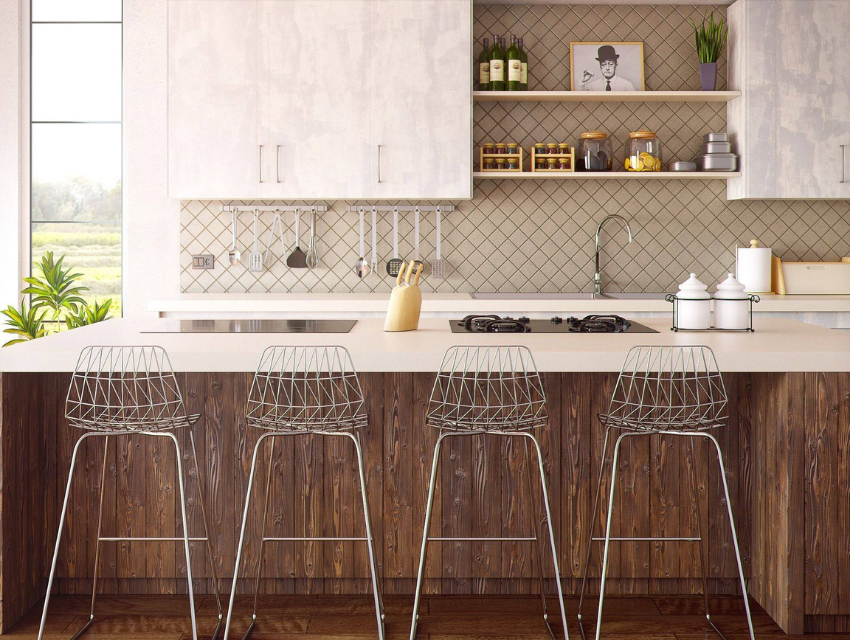It probably comes as no surprise that kitchen renovations are an investment. After all, the kitchen is the most complicated room of the home. It’s filled with electrical, pipes, appliances, built-ins, and so much more.
Despite the complexity that goes into creating the heart of your home, planning a budget for a kitchen renovation isn’t rocket science. Sure, there are several factors involved, including…
the quality of materials like cabinetry
any custom elements designed and ordered
any modifications made (are you moving walls and utilities?)
the quality level of finishes chosen
the availability of the labor market
But the good news? These things can be easily budgeted for — even in a year like 2020, when the supply and labor chains were interrupted for economic, health, and political reasons.
Today we’re demystifying the kitchen renovation budgeting process, pulling back the curtain to share our formula and tips based on 15 years of experience. These will help ease your mind, calm your nerves, and prove that the beautiful kitchen of your dreams may be closer than you imagined… even if you have kiddos running around wildly like we do!
Let’s get started...
Myths and Misconceptions about Your Kitchen Renovation Budget
Before we take a deep dive into how we help you create a kitchen renovation budget, let’s clear up some of the biggest misconceptions surrounding this topic.
Myth #1: Materials Cost More Than Labor
False! They actually cost about the same. The labor costs of the trades and general contractor are often about half of the total project budget. Also, the more structural changes that are made (like moving walls and/or utilities), the higher the labor investment, and therefore the heftier the budget.
Myth #2: Upgrading Finishes Mid-Project Doesn’t Impact the Bottom Line
False again! In our experience, we find that people often budget for basic materials, and then decide to upgrade well into the project, when they are introduced to some of the whiz-bang elements like roll-out drawers and butler pantries. These higher-end selections always increase BOTH the material AND labor costs.
Plus, you never know which of these selections will cause a domino effect and impact other design elements of the home, which may also increase the investment.
Myth #3: Budgets are Set in Stone Once Approved
Completely false! Many people fail to imagine that they will actually need to have some flexibility in their budget if revisions are made to the scope. They accept an off-the-cuff figure given by their contractor or cabinet-shop and don’t bother to dissect it or understand the intricacies. (Which is why we don’t do it this way.)
We help our clients nail down their budgets, but also understand each detail so they know (and can take advantage of) the flexibility accounted for in their investment as the project progresses.
Our Formula for Creating Your Most Accurate Kitchen Renovation Budget
With those misconceptions out of the way, we can jump right into the three steps that we use at Design Inside for establishing any renovation budget:
(1) preliminary budgeting
(2) design-based budgeting
(3) revision-based budgeting
Here’s what that looks like…
Step 1: Preliminary Budgeting
We begin the design process by discussing appliances...those that are remaining in the kitchen, those that are being replaced, and the caliber of the new appliances desired.
Then our team does a quick calculation of linear feet with one of the potential designs for cabinetry. We measure the square footage for the countertops. We add in the cost of backsplash, lighting, flooring, etc.
Once we have our materials figure, then we always say, “Let’s budget this same number for the labor.” Figure doubled...and now we have a very basic budget to work with. Sound simple enough so far? We think so!
Step 2: Design-Based Budgeting
With the basic budget in hand, we get busy creating and approving (on your side) the final design for the kitchen. We request multiple cabinet bids from our network of tradesmen, select the exact countertops, choose the tile, pendant lighting, faucet fixtures, hardware, and every other little kitchen element needed.
Having these selections made so early on in the process means that the materials budget is accurate down to the penny...sometimes even before the contractor has been selected and hired. Over the last 15 years, we have seen that this step is essential to a successful project.
Inside Scoop: It is not only wise for you to know your investment going into a project (no one wants to run out of funds halfway through), but it’s great for the contractor as well. With such a complete picture of the project created, contractors can give you a much more accurate bid. When they don’t have such a clear design-based budget, they use a “fudge factor” to guess the cost of all of the unknowns. This could mean a big difference in your contractor’s initial bid versus the final bill.
During this phase of the budgeting process, we always acquire three different contractor bids. This helps ensure we are getting you the best rates and the best quality work, and it provides an opportunity for final revisions to the budget.
You see, during these bidding walk-throughs with contractors, oftentimes new design ideas or hidden concerns are brought to the table. Which leads us to the essential third budgeting step…
Source: Modern Chicago Kitchen Remodel by Design Inside
Step 3: Revision-Based Budgeting
The final step is revising the budget to account for any new discoveries. For example, if a contractor bid determines that moving a wall is cost-prohibitive, and therefore the kitchen layout we had previously agreed upon needs to change, we make the necessary revisions, submit them to the general contractors for re-bidding, and then assist you with the contract comparisons and negotiations.
By taking the kitchen renovation budgeting process step by step, we are able to not only help you manage your budget from conception to completion, but we can also provide the most accurate estimates possible so that there are no financial surprises along the way.
(Because let’s be real...when you’re watching HGTV or DiY Network and big-ticket items pop up unexpectedly during a remodel, it is NEVER a positive thing for anyone. We aim to avoid that at all costs! Trust us, we have designed kitchens for those shows)
Ballpark Budgets Based on Your Project’s Scope and Size
Okay, the moment you’ve been waiting for, right? Numbers.
Kitchen investments really do vary widely based on all of the above factors, which is why I always hesitate to put numbers out there until we have your project’s specifics in front of us.
However, we have found that this chart provides a basic but helpful framework for homeowners who are in the idea stage of their remodel and are curious about typical investment ranges. Take a look…
But before you get any further, we encourage you to take a step back and make your project plan before you bring a general contractor into the mix. Put in the work up-front by taking at least 3 months to plan your remodel (check out our blog post on designing a kitchen layout that works for you). By doing so, you’ll reduce stress and have ample time to make informed decisions without the pressure of tradespeople waiting for your selections.
Final Thoughts on Budgeting for a Kitchen Renovation
As I mentioned earlier, the budgeting process can be overwhelming, especially for a kitchen renovation with many moving parts to account for. But having a basic understanding of your investment and a framework for developing an accurate budget will help ease your mind every step of the way. (And if you’re looking for a helpful tool, check out our budget planning guide below!)
Lastly, if you want some help with this planning process — making educated design choices, accounting for investment, and assessing labor availability — let’s chat. We’d be honored to help you from day one, dreaming, creating, budgeting, and planning your perfect kitchen...together!
Until next month,
Kathryn






